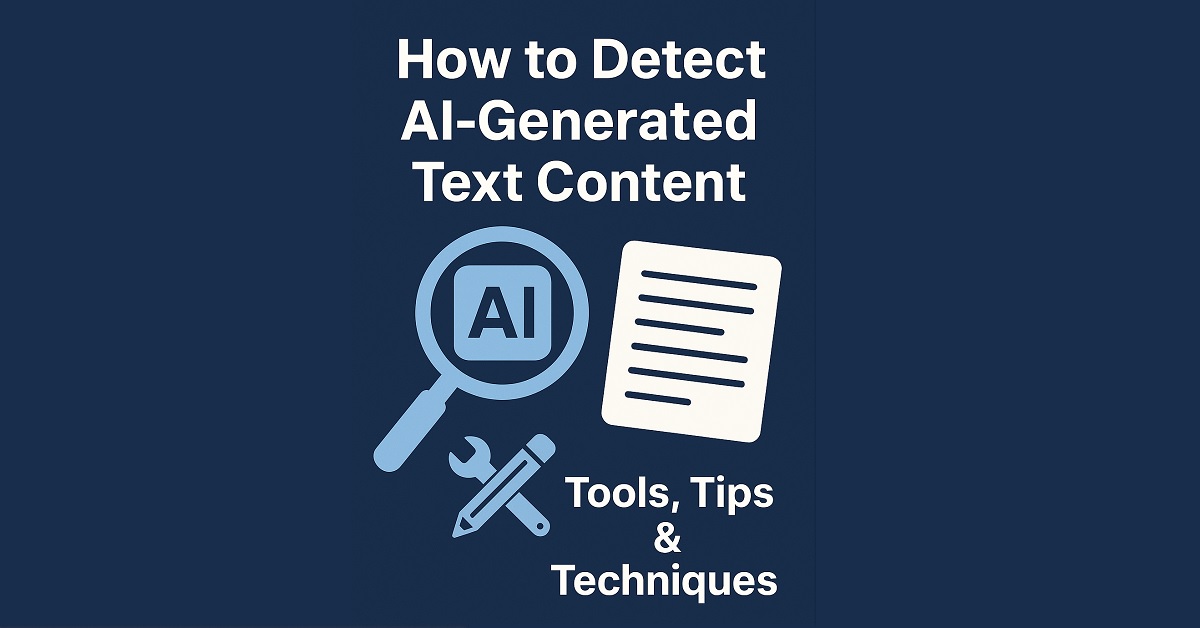In the era of advanced artificial intelligence, generating high-quality text using AI models like ChatGPT, Gemini, or Claude has become incredibly easy. While this technology is helpful in many ways, it also raises an important question:
“How can you detect whether a piece of text is AI-generated or written by a human?”
Whether you’re a teacher, employer, blogger, or researcher, knowing how to spot AI-generated content is essential for maintaining authenticity, trust, and originality. In this blog post, we’ll explore various tools, signs, and manual methods to detect AI-generated text content.

🔍 Why Detecting AI-Generated Text is Important
- ✅ To identify plagiarism or academic dishonesty
- ✅ For maintaining editorial integrity in journalism
- ✅ To combat misinformation or bot-generated fake news
- ✅ For SEO professionals who want original human-written content
- ✅ To uphold transparency in communication and authorship
🧰 Best Tools to Detect AI-Generated Text Content
Several free and paid tools are available that analyze text and predict whether it was likely written by AI or a human. Here are the top ones:
1. OpenAI AI Text Classifier (Retired)
While OpenAI’s own classifier was discontinued, it sparked the rise of other tools.
2. GPTZero
- Website: gptzero.me
- Features: Detects AI-generated essays, assignments, and blog posts.
- Ideal for: Teachers and educators
- Output: Highlights AI-written sections and gives a probability score
3. Originality.AI
- Website: originality.ai
- Paid Tool, but highly accurate
- Detects GPT-3, GPT-4, Bard, Claude, and paraphrased AI content
- Also checks for plagiarism
4. Writer.com AI Content Detector
- Free tool to detect if text is AI-generated
- Results show how predictable the writing is (AI = high predictability)
5. Copyleaks AI Detector
- Detects AI-written academic and commercial content
- Supports multiple languages
- Offers API and LMS integration for institutions
6. Sapling AI Detector
- Quick web-based tool with high accuracy
- Highlights sentences with high AI probability
🔎 Manual Ways to Detect AI-Generated Text
Even without tools, you can look for these signs to suspect AI authorship:
✍️ 1. Repetitive or Over-Structured Phrasing
AI tends to repeat sentence structures, phrases, or use a very predictable flow.
📏 2. Lack of Personal Experience
No personal opinions, emotions, or anecdotal stories — very factual or robotic tone.
📄 3. Overuse of Generic Language
Frequent use of terms like “It is important to note that”, “In conclusion”, or “Moreover” may signal AI writing.
❌ 4. Missing Context or Subtle Errors
AI may misstate facts or reference fictional data in a confident tone.
🧠 5. Shallow Depth
AI writing may look perfect but often lacks real insight, depth, or fresh thought.
📑 Tips to Stay Ahead
- Run all content through AI + Plagiarism detection tools
- Cross-check suspicious facts or claims
- Ask for personal reflection, which AI cannot generate convincingly
- Include source citations or real-life examples in required text
💡 Use Case Examples
| Use Case | Recommended Tool |
|---|---|
| School Essays | GPTZero, Copyleaks |
| Blog Articles | Originality.AI |
| Job Applications | Sapling, Writer.com |
| Academic Papers | Copyleaks, Turnitin (AI + Plagiarism) |
🔚 Conclusion
AI-generated text can be incredibly convincing — but not undetectable. By combining advanced detection tools and manual judgment, you can easily separate human-written content from synthetic AI output.
Whether you’re screening articles, reviewing assignments, or verifying content originality, knowing how to detect AI-generated text is a digital literacy skill for the future.